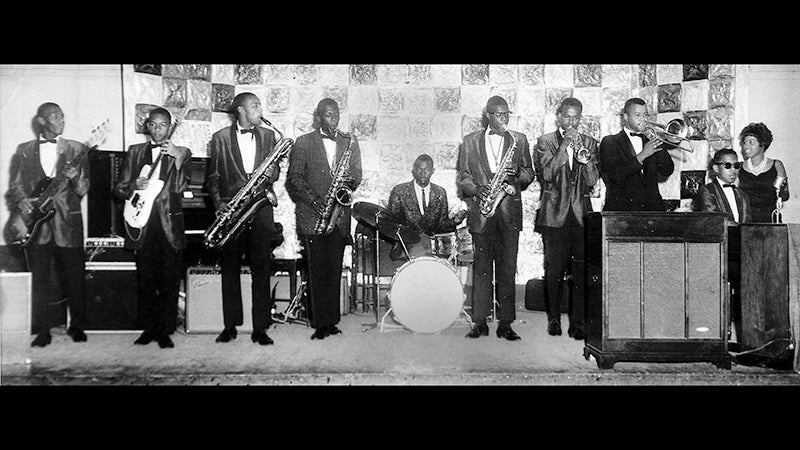Music at Midway
Published 3:42 pm Tuesday, November 27, 2018

- Claude Askew, Curtis Burley, Ves Artis, Everett "Blood" Hollin, Henderson Key, Charles "Skip" Fennell and Florine Wright, all of Carver High School, played at Midway Park.
Story by Phyllis Speidell
Photos by John H. Sheally II
The party lights were on when thousands of music fans made the scene at Midway Park’s opening in Suffolk over the July 4 weekend in 1961.
The weekend’s entertainment lineup was dazzling — James Brown, Gladys Knight and the Pips, The Drifters, Clyde McPhatter, Claudine Clark, Shep and the Limelites — and the Rockateers.
The Rockateers? The local group on stage that weekend was Sylvester “Ves” Artis and his band of Carver High School students and alumni from Newport News. The Rockateers, many still 15 or 16 years old, opened for some of the biggest names in early ’60s R&B.
Artis remembers his band being somewhat in awe and rushing to help the visiting, better-known performers, some not much older than the Rockateers, with their luggage and instruments.
“We all got to know each other, “he said. “It was a new venue, and it was fun.”
He also remembers his mother — equipped, he jokes, with the nose of a bloodhound — kept a close eye on the young band, making sure they weren’t drinking or smoking.
Artis’ uncle ran a bus company and chartered out buses to bring in music fans to Midway from North Carolina and all over southeastern Virginia. He uncle also had a big blue limo — sized just right to carry the Rockateers, sporting orange sequined jackets, to the park’s opening in style.
Part of the Midway Park mystique was its location just outside the tiny crossroads community of Driver in what was then Nansemond County. Most of the performers, barred from local restaurants, frequented the crossroads stores to buy sandwiches and drinks, post handbills advertising the park and chat with the locals.
Residents in Driver remember sitting on their porches to enjoy the music of Lloyd Price, The Marvalettes, Flip Flop Stephens, The Platters and more as it drifted across the country air.
Midway Park was one of a handful of parks developed before integration as black resorts with motels, dance halls, beaches, lakes and concert settings. Floyd Cooper, who had developed another successful black resort, Sunset Park, in Deep Creek in 1955, created Midway Park from 144 acres of farmland in just three months.
Newspaper accounts said when McPhatter arrived for the opening he told Cooper, “I was through this area just a while ago on a one-nighter tour and all that was here was a bunch of trees — now look at it!”
The opening nights offered free cold beverages on Friday, autographed recordings to the first 500 ladies on Saturday evening and a Sunday raffle for a hi-fi stereo record player.
Artis said he rarely looked out from the stage to estimate an audience count, but he knows those nights the numbers ran into the thousands.
When integration became the law, black amusement parks became passé. Midway Park closed in early 1964.
The Rockateers stayed together until the late 1960s.
“We played the Chitlin’ Circuit,” Artis said, adding that he later played some of the most popular venues in the area and played with Marvin Gaye, Patti La Monte who later became Patti Labelle, the O’Jays, Bo Diddley and Bill Deal.
When the Rockateers all went their separate ways, Artis went into jazz.
Artis, now in his mid-70s, has been a musician all his life. His father, born in Chuckatuck, was a professional musician, a pianist who played with the Royal Hamptonians at Hampton University. He made a living delivering mail for the U.S. Postal Service. He tried to persuade his son to play piano or clarinet, but from the age of 4, Ves Artis knew he wanted to play a saxophone.
An Army musician, a friend of his father, gave the young Artis a used saxophone, tarnished silver and unable to play past G, but it was the start he needed. Over the years, Artis graduated from Carver High School and Norfolk State, served a year in Vietnam with the U.S. Army, owned a series of music stores that bought and sold instruments, offered rentals and lessons and kept him in constant touch with the music that made his life. He continued to play at venues around Virginia and the Outer Banks and played with The Cabarets, one of the area’s first integrated bands.
Currently, he owns The World of Music shop in the Southampton Shopping Center in Hampton.
A few years after the park closed, a businesswoman, Mary C. Williams, built a two-story house in front of the motel and opened the “Senior Citizens Village,” which eventually closed too.
A group of 14 investors from Norfolk and Portsmouth bought the remaining 120 acres of the Midway Park site to develop an affordable housing project of 400 homes priced at $12,000 to $14,000. A six-acre commercial/retail center was part of the plan as well as underground utilities and plenty of room for churches and recreational green spaces. Premier Development Corporation hoped to start with 50 homes — all brick and California redwood construction — and build more as the demand increased.
Although the area remains listed as the Midway Park subdivision, few of the planned homes ever materialized.
Artis knows that Midway Park’s musical memories are also fading, and his hope now is that they might be kept alive with a Virginia historical highway marker placed along Nansemond Parkway to commemorate the musical phenomenon that was Midway Park.
As Diana Ross sang a few years after Midway Park closed, “Remember me as a good thing.”






